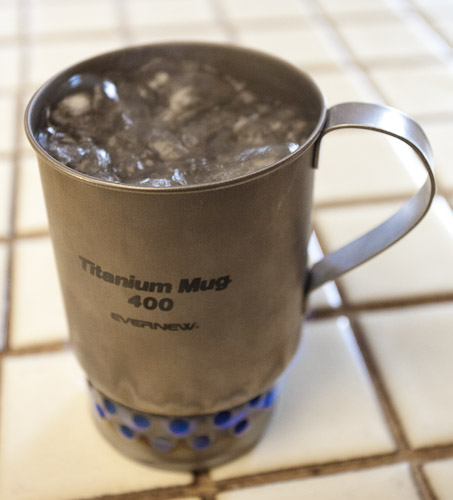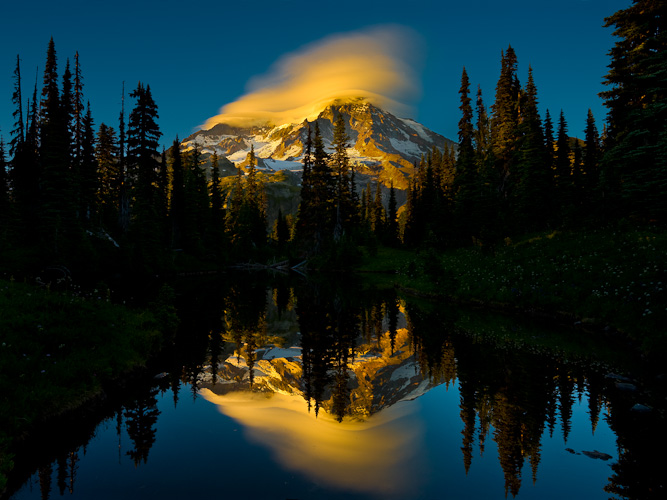Making room for camera gear: More backpacking ideas for pack, footwear, stove, water, food, misc.

This month (December) was about planning for next year, and part of the 2012 plan is quicker and lighter backpack trips. I won’t compromise on photography, so the Canon 5D II, an adequate tripod and a trim list of accessories get a pass. Everything else gets shrunk, squeezed, scissored, siliconized, dehydrated or discarded.
To find load-lightening ideas, I perused a few ultra-light backpacking books. My favorite is Ultralight Backpackin’ Tips, (Falcon Guides, 2011) by Mike Clelland. The advice is so good, I combed through it twice, cherry-picking everything I thought useful. Ultralight Backpackin‘ is easy, organized reading. Even better, every page of the book entertains with illustrations that mimic classic (Keep on Truckin’) Robert Crumb. After looking at Clelland’s illustrations on hanging food in bear country, I headed for the back yard to burn his know-how into muscle memory. I liked so many of the simple tips as well, like the one to improve the performance of a mini BIC lighter. If your desire is to chase the light up in the high country, Ultralight Backpackin’ Tips improves the odds.
I’ve covered the backpacking topic twice before: Backpacking and Photography Re-visit and Light-Weight Backpacking and Photography. Here’s some new ideas, mostly gleaned from Clelland.

Create a Spreadsheet
I’ve used an Excel spreadsheet for years to tally both kayaking and backpacking gear. A few weeks ago, I scrapped the backpack one and started fresh, based on the table in Clelland’s book. I re-weighed all my gear in grams with a (Weight Watcher) scale, then converting to ounces with a parallel column on the spreadsheet. Like Clelland, I now have my base weight, consumables, pack weight and wear weight separated for easy viewing.
Pack
I’ve got two years use on my Golite Jam, a just adequate 3,000 in3 pack that weighs two lbs off the shelf. Clelland used the same pack, but he’s taken the scissors to it and cut the weight to 17 ounces! It isn’t easy trimming a new pack. All those tabs and loops and compartments and inserts are sewn in for a purpose, aren’t they? Well, if you don’t need it, Clelland says cut it out. I shortened the strap lengths, and removed some padding, cutting the weight of my pack from thirty-two to twenty-seven ounces. I suppose that makes me one-third the zealot that Clelland is; I’m a work in progress.
Stove
For years I’ve used a canister stove for backpacking, a 3 oz MSR Pocket Rocket. The canisters weigh 3 oz empty, so that’s 6 oz before adding the fuel weight. It also means that at minimum you’ll be packing 6 oz out, and have a canister to dispose of. Guided by Clelland’s alcohol stove tip, I made a simple stove from a 3 oz Bumble Bee tuna can. It weighs .6 oz and boils 11 oz of water in seven minutes. You can view a how-to for the stove at http://www.youtube.com/watch?v=pajkt594Ruw.
A fuel container (plastic) for carrying a 2-oz volume of denatured alcohol (ethanol/methanol) or wood alcohol (methanol) weighs half an ounce; an 8-oz container, one ounce. With the handmade stove I can boil water for coffee in my titanium cup instead of a titanium pot (5 more oz saved). Everything (stove, lighter, fuel) fits inside the cup on a two-night adventure. For short, 2-4 night trips, the alcohol stove saves weight. For longer trips, it may be a wash or even a negative, because the canister gas delivers about double the energy compared to alcohol. Delivery efficiency is another factor, which I haven’t quantified.

Shelter
I’m still using a tent, and in 2011 I sprung for a Big Agnes Fly Creek two-person model, made of silnylon and weighing in at 2.3 lb, including stuff sacks and guy lines but without stakes and ground cloth. It’s quite compact, saving space in the pack. On three outings so far, performance is good, though the juries out on longevity. It’s cramped but serviceable for two; light enough I’m using it solo.
Footware
I’ve had my share of close calls with sprained ankles over the years, and for that reason tend to favor a heavier boot for backpacking. For the last two years, though, I’ve been running for training, and my ankles are so much stronger now I believe it is the reason I had no ankle mishaps or even close calls on 2011 backpack trips. In 2012, I’ll try a trail running shoe for moderate backpacking. Keep in mind that every time you lift a foot, its work—roughly fivefold more work than if the equivalent weight was in your pack.
On the last hike I did this year, in early November, I walked in heavy winter boots to Spray Park at Mt. Rainier. The three-mile trip took 10 minutes longer than it usually does, and I felt more fatigued. I blame the heavy boots.
Water
I’ve been carrying less and less water on the trail. Instead, I hydrate heavily at the start of the day. Then after the water runs out, I stop and filter with my MSR Hyperflow. Quoting Ryan Jordan (from Clelland’s tip 101) “If you arrive at a water source with water still on your back, you have made a mistake.” You absolutely need to stay hydrated, but in many backpacking destinations, good water is never far away. Don’t unthinkingly load up with 32 or 64 oz at the trailhead because that’s what you always do. If there’s a reliable water source two miles up the trail, calculate what gets you there. Maybe you can save a couple pounds at the start—and throughout—each day.
Food
I rather enjoyed Clelland’s tip on Fritos: “Corn, oil and salt. That’s all . . .160 calories per ounce.” That’s a decent bang for the buck; efficient calories. He also has some dinner recipe ideas (rice and lentils, rice and beans) that look worthy.

Misc
I got interested in night photography this year, beyond the easier stuff like long-exposure star-trails. It’s difficult to compose at night through a viewfinder, or even see the stars. One thought is to replace my 3 oz Petzl Tikka LED headlamp with a 1.7 oz Mammut s-flex, which runs on a single double-A and has a red LED option for night vision. I’ve only looked at the s-flex in the store, so I can only say if you’re in need of a headlamp and do night photography, take a look. In the short run, I’ll keep my Petzl and carry a makeshift, tape-on, red film gel.
Go-Box
Put all the essentials for an overnight trip in one box. Clelland calls his the “Go-Box”. The spontaneous decision that gets you to the trailhead a few hours before sunset can only happen if you’re ready. And ready includes food, so have your breakfast and dinner ready to go in the fridge. Deploy a separate box for photo gear as well—with lenses clean, cards cleared and batteries charged. That lenticular-cloud sunset beckons.
Happy trails
Gary